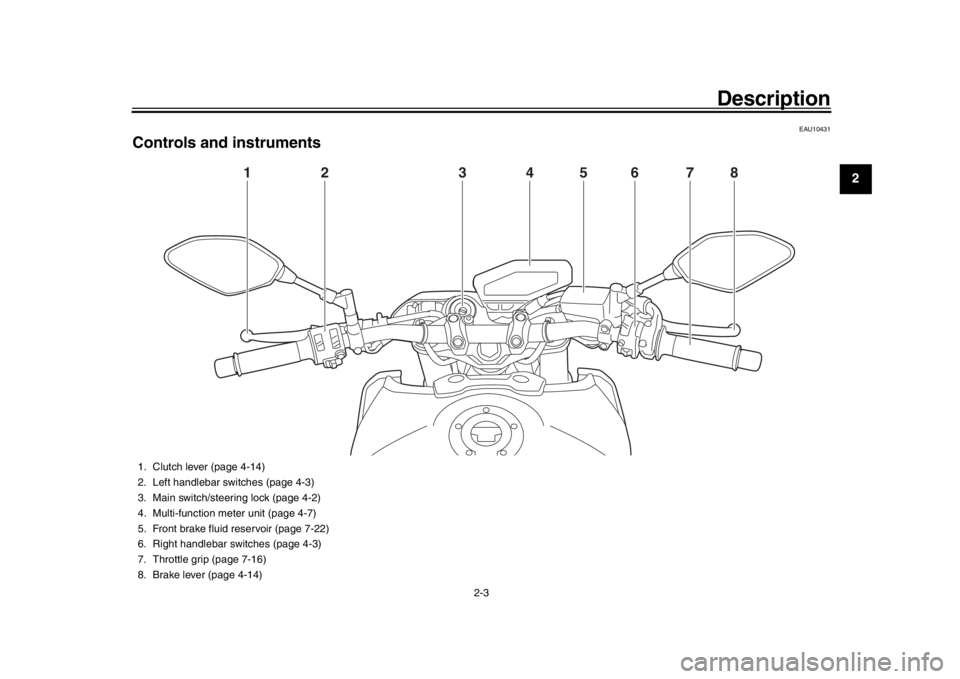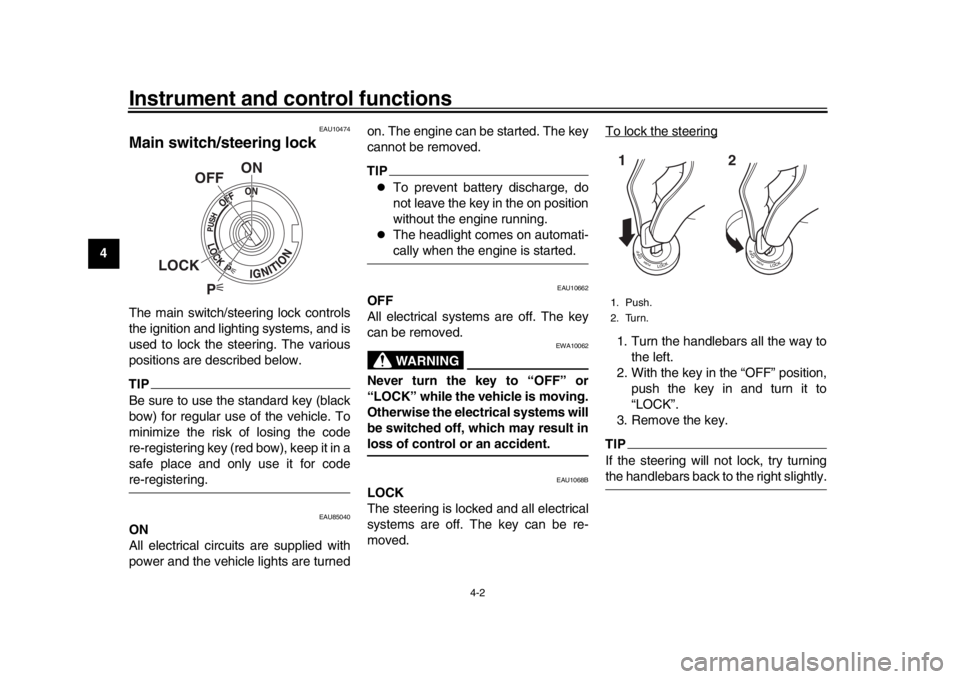YAMAHA MT-09 2019 User Guide
Manufacturer: YAMAHA, Model Year: 2019, Model line: MT-09, Model: YAMAHA MT-09 2019Pages: 104, PDF Size: 7.14 MB
Page 11 of 104

Safety information
1-4
12
3
4
5
6
7
8
9
10
11
12
dorse nor recommend the use of ac-
cessories not sold by Yamaha or
modifications not specifically recom-
mended by Yamaha, even if sold and
installed by a Yamaha dealer.
Aftermarket Parts, Accessories,
and Modifications
While you may find aftermarket prod-
ucts similar in design and quality to
genuine Yamaha accessories, recog-
nize that some aftermarket accessories
or modifications are not suitable be-
cause of potential safety hazards to you
or others. Installing aftermarket prod-
ucts or having other modifications per-
formed to your vehicle that change any
of the vehicle’s design or operation
characteristics can put you and others
at greater risk of serious injury or death.
You are responsible for injuries related
to changes in the vehicle.
Keep the following guidelines in mind,
as well as those provided under “Load-
ing” when mounting accessories.
Never install accessories or carry
cargo that would impair the perfor-
mance of your motorcycle. Care-
fully inspect the accessory before using it to make sure that it does
not in any way reduce ground
clearance or cornering clearance,
limit suspension travel, steering
travel or control operation, or ob-
scure lights or reflectors.
Accessories fitted to the handle-
bar or the front fork area can
create instability due to improper
weight distribution or aerody-
namic changes. If accessories
are added to the handlebar or
front fork area, they must be as
lightweight as possible and
should be kept to a minimum.
Bulky or large accessories may seriously affect the stability of
the motorcycle due to aerody-
namic effects. Wind may at-
tempt to lift the motorcycle, or
the motorcycle may become un-
stable in cross winds. These ac-
cessories may also cause
instability when passing or being
passed by large vehicles.
Certain accessories can dis- place the operator from his or
her normal riding position. This
improper position limits the free- dom of movement of the opera-
tor and may limit control ability,
therefore, such accessories are
not recommended.
Use caution when adding electri-
cal accessories. If electrical acces-
sories exceed the capacity of the
motorcycle’s electrical system, an
electric failure could result, which
could cause a dangerous loss of
lights or engine power.
Aftermarket Tires and Rims
The tires and rims that came with your
motorcycle were designed to match the
performance capabilities and to provide
the best combination of handling, brak-
ing, and comfort. Other tires, rims, siz-
es, and combinations may not be
appropriate. See page 7-17 for tire
specifications and for information on
servicing and replacing your tires.
Transporting the Motorcycle
Be sure to observe following instruc-
tions before transporting the motorcy-
cle in another vehicle.
Remove all loose items from the
motorcycle.
BS2-9-E2.book 4 ページ 2018年8月10日 金曜日 午前9時36分
Page 12 of 104

Safety information
1-5
1
2
3
4
5
6
7
8
9
10
11
12
Check that the fuel cock (if
equipped) is in the off position and
that there are no fuel leaks.
Shift the transmission into gear (for
models with a manual transmis-
sion).
Secure the motorcycle with
tie-downs or suitable straps that
are attached to solid parts of the
motorcycle, such as the frame or
upper front fork triple clamp (and
not, for example, to rubber-mount-
ed handlebars or turn signals, or
parts that could break). Choose
the location for the straps carefully
so the straps will not rub against
painted surfaces during transport.
The suspension should be com-
pressed somewhat by the
tie-downs, if possible, so that the
motorcycle will not bounce exces-
sively during transport.
BS2-9-E2.book 5 ページ 2018年8月10日 金曜日 午前9時36分
Page 13 of 104

2-1
123
4
5
6
7
8
9
10
11
12
Description
EAU10411
Left view
3
4
5
6
7
8
1, 2
1. Spring preload adjuster (page 4-21)
2. Compression damping force adjuster (page 4-21)
3. Rebound damping force adjuster (page 4-23)
4. Seat (page 4-20)
5. Storage compartment (page 4-20)
6. Spring preload adjuster (page 4-23)
7. Shift pedal (page 4-14)
8. Engine oil drain bolt (page 7-11)
BS2-9-E2.book 1 ページ 2018年8月10日 金曜日 午前9時36分
Page 14 of 104

Description
2-2
12
3
4
5
6
7
8
9
10
11
12
EAU10421
Right view
2
1
6
7
8
9
10
5 3, 4
1. Fuses (page 7-31)
2. Fuel tank cap (page 4-16)
3. Spring preload adjuster (page 4-21)
4. Rebound damping force adjuster (page 4-21)
5. Coolant reservoir (page 7-14)
6. Engine oil level check window (page 7-11)
7. Engine oil filler cap (page 7-11)
8. Brake pedal (page 4-15)
9. Rear brake light switch (page 7-21)
10.Rear brake fluid reservoir (page 7-22)
BS2-9-E2.book 2 ページ 2018年8月10日 金曜日 午前9時36分
Page 15 of 104

Description
2-3
123
4
5
6
7
8
9
10
11
12
EAU10431
Controls and instruments
1
2
3
4
5
6
7
8
1. Clutch lever (page 4-14)
2. Left handlebar switches (page 4-3)
3. Main switch/steering lock (page 4-2)
4. Multi-function meter unit (page 4-7)
5. Front brake fluid reservoir (page 7-22)
6. Right handlebar switches (page 4-3)
7. Throttle grip (page 7-16)
8. Brake lever (page 4-14)
BS2-9-E2.book 3 ページ 2018年8月10日 金曜日 午前9時36分
Page 16 of 104

3-1
1
23
4
5
6
7
8
9
10
11
12
Special features
EAU76422
D-mode (drive mode)D-mode is an electronically controlled
engine performance system. This mod-
el has three mode selections: “STD”,
“A”, and “B”.
WARNING
EWA18440
Do not change the drive mode whilethe vehicle is moving.
With the throttle grip closed, push this
switch to change the drive mode in the
following order:
STD A B STDTIP
Make sure you understand each
drive mode before operating the drive mode switch.
The current drive mode is shown in
the drive mode display (page
4-10).
The current drive mode is savedwhen the vehicle is turned off.
Mode “STD”
Mode “STD” is suitable for various rid-
ing conditions.
This mode allows the rider to enjoy
smooth and sporty drivability from the
low-speed range to the high-speed
range.
Mode “A”
Mode “A” offers a sportier engine re-
sponse in the low- to mid-speed range
compared to mode “STD”.
Mode “B”
Mode “B” offers response that is some-
what less sharp compared to mode
“STD” for riding situations that require
especially sensitive throttle operation.
EAU76434
Traction control systemThe traction control system (TCS)
helps maintain traction when accelerat-
ing on slippery surfaces, such as un-
paved or wet roads. If sensors detect
that the rear wheel is starting to slip (un-
controlled spinning), the traction control
system assists by regulating engine
power as needed until traction is re-
stored.
WARNING
EWA15433
The traction control system is not a
substitute for riding appropriately
for the conditions. Traction control
cannot prevent loss of traction due
to excessive speed when entering
turns, when accelerating hard at a
sharp lean angle, or while braking,
and cannot prevent front wheel slip-
ping. As with any vehicle, approach
surfaces that may be slippery with
caution and avoid especially slip-pery surfaces.
1. Drive mode switch “MODE”
1
BS2-9-E2.book 1 ページ 2018年8月10日 金曜日 午前9時36分
Page 17 of 104

Special features
3-2
1
234
5
6
7
8
9
10
11
12
Setting the traction control system
With the throttle closed, push this
switch down to change from TCS “1” to
TCS “2”. Push up to change from “2” to
“1”.
With the vehicle stopped, push this
switch up for two seconds to turn the
system off. Push down to turn the sys-
tem on.
TIP
The current TCS setting is shown
in the TCS display (page 4-10).
Traction control can be turned on
or off only when the vehicle is
stopped.
When the key is turned to “ON”,
traction control is turned on and set to “1” or “2” (whichever was last
selected).
Turn the traction control system off
to help free the rear wheel if the ve-
hicle gets stuck in mud, sand, orother soft surfaces.
TCS “OFF”
TCS “OFF” turns the traction control
system off.
TCS “1”
TCS “1” minimizes traction control as-
sist.
TCS “2”
TCS “2” maximizes traction control as-
sist; wheel spin is most strongly con-
trolled. The “ ” indicator light flashes when
traction control has engaged. You may
notice slight changes in engine and ex-
haust sounds when the system has en-
gaged.
When the traction control system has
been set to “OFF”, the “ ” indicator
light will come on.
NOTICE
ECA16801
Use only the specified tires. (See
page 7-17.) Using different sized
tires will prevent the traction control
system from controlling tire rotationaccurately.
1. Traction control system switch “TCS”
1
1. Traction control system indicator light
“”
2. Engine trouble warning light “ ”
12
BS2-9-E2.book 2 ページ 2018年8月10日 金曜日 午前9時36分
Page 18 of 104

Special features
3-3
1
23
4
5
6
7
8
9
10
11
12 Resetting the traction control sys-
tem
The traction control system will auto-
matically disable when:
the front wheel or rear wheel
comes off the ground while riding.
excessive rear wheel spin is de-
tected while riding.
either wheel is rotated with the key
turned to “ON” (such as when per-
forming maintenance).
If the traction control system is dis-
abled, both the “ ” indicator light and
the “ ” warning light will come on.
Should this occur, try resetting the sys-
tem as follows. 1. Stop the vehicle and turn the key to “OFF”.
2. Wait a few seconds and then turn the key back to “ON”.
3. The “ ” indicator light should turn off and the system be enabled.
TIPIf the “ ” indicator light remains on af-
ter resetting, the vehicle may still be rid-
den; however, have a Yamaha dealercheck the vehicle as soon as possible.
4. Have a Yamaha dealer check the vehicle and turn off the “ ” warn-
ing light.
EAU76401
Quick shift systemThe quick shift system (QS) allows for
full-throttle, clutch lever-less, electroni-
cally-assisted upshifts. When the shift
switch detects motion in the shift pedal
(page 4-14), engine power and drive
torque are momentarily adjusted to al-
low the upshift to occur.TIP
The quick shift system operates
when traveling at least 20 km/h (12
mi/h) with an engine speed of 2300
r/min or higher, and only when ac-
celerating.
It does not operate when the clutchlever is pulled.
BS2-9-E2.book 3 ページ 2018年8月10日 金曜日 午前9時36分
Page 19 of 104

4-1
1
2
345
6
7
8
9
10
11
12
Instrument and control functions
EAU10979
Immobilizer systemThis vehicle is equipped with an immo-
bilizer system to help prevent theft by
re-registering codes in the standard
keys. This system consists of the fol-
lowing:
a code re-registering key
two standard keys
a transponder (in each key)
an immobilizer unit (on the vehicle)
an ECU (on the vehicle)
a system indicator light (page 4-6)
About the keys
The key with the red bow is used to reg-
ister codes in each standard key. Store the code re-registering key in a safe
place. When necessary, take the vehi-
cle along with all three keys to a
Yamaha dealer to have them re-regis-
tered.
Do not use the key with the red bow for
driving. It should only be used for
re-registering the standard keys. Al-
ways use a standard key for driving.
TIP
Keep the standard keys as well as
keys of other immobilizer systems
away from the code re-registering
key.
Keep other immobilizer system
keys away from the main switch as
they may cause signal interfer-ence.
NOTICE
ECA11823
DO NOT LOSE THE CODE RE-REG-
ISTERING KEY! CONTACT YOUR
DEALER IMMEDIATELY IF IT IS
LOST! If the code re-registering key
is lost, the existing standard keys
can still be used to start the vehicle.
However, registering a new stan-
dard key is impossible. If all keyshave been lost or damaged, the en-
tire immobilizer system must be re-
placed. Therefore, handle the keys
carefully.
Do not submerse in water.
Do not expose to high tempera-
tures.
Do not place near magnets.
Do not place near items that
transmit electrical signals.
Do not handle roughly.
Do not grind or alter.
Do not disassemble.
Do not put two keys of any im-
mobilizer system on the samekey ring.
1. Code re-registering key (red bow)
2. Standard keys (black bow)
BS2-9-E2.book 1 ページ 2018年8月10日 金曜日 午前9時36分
Page 20 of 104

Instrument and control functions
4-2
1
2
34
5
6
7
8
9
10
11
12
EAU10474
Main switch/steering lockThe main switch/steering lock controls
the ignition and lighting systems, and is
used to lock the steering. The various
positions are described below.TIPBe sure to use the standard key (black
bow) for regular use of the vehicle. To
minimize the risk of losing the code
re-registering key (red bow), keep it in a
safe place and only use it for codere-registering.
EAU85040
ON
All electrical circui ts are supplied with
power and the vehicle lights are turned on. The engine can be started. The key
cannot be removed.
TIP
To prevent battery discharge, do
not leave the key in the on position
without the engine running.
The headlight comes on automati-cally when the engine is started.
EAU10662
OFF
All electrical systems are off. The key
can be removed.
WARNING
EWA10062
Never turn the key to “OFF” or
“LOCK” while the vehicle is moving.
Otherwise the electrical systems will
be switched off, which may result inloss of control or an accident.
EAU1068B
LOCK
The steering is lock
ed and all electrical
systems are off. The key can be re-
moved. To lock the steering
1. Turn the handlebars all the way to
the left.
2. With the key in the “OFF” position, push the key in and turn it to
“LOCK”.
3. Remove the key.TIPIf the steering will not lock, try turningthe handlebars back to the right slightly.
P
ON
OFF
LOCK
1. Push.
2. Turn.12
BS2-9-E2.book 2 ページ 2018年8月10日 金曜日 午前9時36分